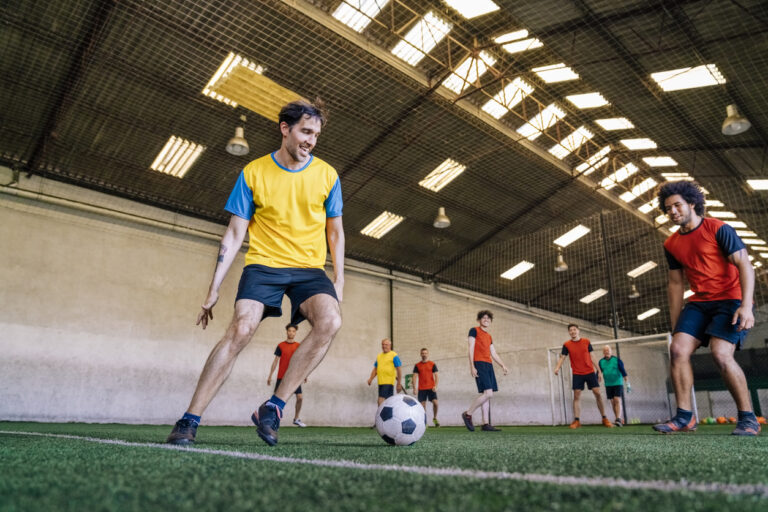What are the main positions and roles within futsal?
Futsal has its brief moments of coming to the forefront of media attention; for example, when the English Premier League’s Wolverhampton Wanderers signed former England international futsal player Max Kilman in May 2019, the acquisition was followed by a flurry of articles and interviews highlighting the connection between football and futsal.
Nonetheless, media attention of futsal has a habit of coming into mainstream discussions every now and then but evaporating again before casual viewers have an opportunity to truly understand the court-based game. As a result, the game’s essence, tactics, and positional play can easily be misunderstood unless supporters are paying particular interest to futsal.
With Lithuania’s 2024 UEFA World Cup around the corner, a growing number of football fans are interested in learning more about futsal and how the game flows. There’s never been a better time to get into the world’s fastest-growing indoor sports game. So, what are the main positions in futsal, who are the best players to perform each role, and how do they fit together in a tactical system?
How many players are on a futsal team?
Futsal is played with five players on either team; unlike football and due to the fast-paced nature of the game, rolling substitutions are allowed with a bench consisting of up to seven players.
The most well-known and definable positions of the five players on the court are:
- Goalkeeper
- Defender
- Pivot
- Winger
Let’s take a thorough look at each position and assess the different formations they can line up in.
The goalkeeper
As with 11-a-side football, the goalkeeper between the sticks represents the final line of defence in futsal. However, with the court being significantly smaller than an 11-a-side football pitch and thus being called into action to stop shots more regularly, goalkeepers are required to maintain extensive focus for pretty much the entire game. There is rarely a phase of play where a team keeps the ball in the opposing team’s half for extended periods of time; regular turnovers and transitions mean that even when the goalkeeper’s team is on the attack, they could suddenly be called into action to make a crucial save just a few seconds later.
The distributional and ball-playing abilities of goalkeepers in 11-a-side football are becoming increasingly imperative in starting their team’s build-up play, and this is no different in futsal. The goalkeeper is responsible for calmly playing the ball to a teammate ready to counter or, on occasion, playing an exquisite defence-splitting up the court to create a goalscoring opportunity. The decision-making of a goalkeeper’s distribution is even more important, since any misplaced pass leaves their team vulnerable to attacking opportunities from the opposition.
Who’s the greatest futsal goalkeeper of all time?
Leo Higuita, the Brazilian-born Kazakhstan international goalkeeper, is widely regarded as one of the all-time greats to demonstrate both smooth ball-playing abilities and essential goal-preventing blocks and saves.
Incredibly, the 37-year-old has scored 27 times for Kazakhstan, a figure he’ll be looking to add to at this Autumn’s UEFA World Cup.
The defender
Defenders are the deepest out-field players on a futsal court; they’re responsible for keeping their teams shape and structure, limiting space in opposition attacks, and making tackles while out of possession.
When the defender’s team have the ball, they perhaps occupy a more offensive and technically centred role than we see many defenders in 11-a-side football perform. While they’ll often play in a narrow shape when the other team attacks, defenders drop wider when their team is in possession to provide better passing angles and create opportunities to carry the ball up the pitch.
With frequent turnovers, pushing too far forward can be risky for defenders in futsal, but when performed successfully, it can create an overload in the opposition’s half. The extent to which defenders have the freedom to express themselves in the final third depends on their manager’s futsal philosophy and the circumstances of a given game.
Defenders to look out for at the 2024 uefa world cup
Portuguese 2021 World Cup-winning defender Fábio Cecílio has had a stellar career, wracking up 99 caps and 26 goals for his country. The 30-year-old, whose passing range and intelligence were critical in Portugal’s triumph three years ago, will be looking for a repeat of his fine performances this Autumn.
Meanwhile, Spain’s 40-year-old defender, Ortiz, will be desperate to cap off an already illustrious career by finally getting his hands on the UEFA World Cup. Ortiz already has Champions League, Supercopa de España, and World Team of the Year accolades to his name, but the World Cup has always alluded the defender, who lost out to Brazil in the 2009 final.
The pivot
Whereas 11-a-side football pivots sit in front of defence and dictate possessional play, the pivot in futsal operates much higher up the pitch and is tasked with holding up and linking play, moving into effective goal-scoring positions, and ultimately finishing off chances.
With the futsal court often being congested, the pivot is unlikely to find space in behind as a striker may in 11-a-side football. So, the pivot’s movement often entails dropping deeper to receive the ball, displaying strong ball control and dribbling skills as they hold off chances and attempt to create space high up the court for others.
In transitions from attack to defence, a successful pivot must cut off passing lanes, hold the team’s shape, and, depending on the team’s individual tactics, counter-press to regain possession in dangerous areas of the court.
Best in the world?
Many argue Brazil’s pivot, Ferrão, is the best futsal player on the planet right now. The 33-year-old Barcelona superstar won three consecutive Player of the Year awards from 2019 to 2021 and will be hoping to show the world his talents once again at this year’s World Cup.
Ferrão possesses the silky samba skills synonymous with attacking Brazilian players and has deadly finishing, having already scored 227 times for Barcelona.
The winger
Futsal wingers are box-to-box wide players, responsible for adding width to defensive structures, moving higher up the pitch in possession, and creating goal scoring opportunities through their endeavour, pace, dribbling, and passing.
With favourable shooting angles, effective wingers have opportunities to score from through balls into wide areas of the court. However, as with all players on the court, there is sometimes a licence to tuck inside, especially when the ball is on the other side of the court.
The greatest futsal players ever
The diverse role of the winger and freedom to move into goalscoring positions means that they’re often the players who receive the most individual praise and accolades.
In Futsal’s ‘Greatest Player of All Time’ debates, two wingers, Falcão and Ricardinho, dominate conversations. Brazilian-born Falcão was perhaps the most entertaining player to ever grace a futsal court, regularly demonstrating mastery of the ball, flair, and creative play to win matches. Meanwhile, Ricardinho has a play style that is perhaps most comparable to Luis Suarez. The Portuguese winger uses his precise ball control to twist and turn defenders’ ankles inside out before unleashing powerful shots at goal to win matches on his own.
What tactical shapes are most common in futsal?
As with football, there are several formation shapes that get deployed from time to time to gain a tactical advantage, but the most common shapes are:
- 1-2-1 (one defender, two wingers, and a pivot)
- 2-1-1
- 2-0-2
- In the 1-2-1 formation, wingers often slot into defence to create a back three out of possession but move into the forward line to create a front three in possession.
- The 2-1-1 see’s two central defender who can move wide in possession, allowing for three attacking players to create an overload in the opposition’s half.
- The 2-0-2 is a box formation, whereby the players occupy the outer width of the court before stepping inside to create space in other key areas for teammates.

